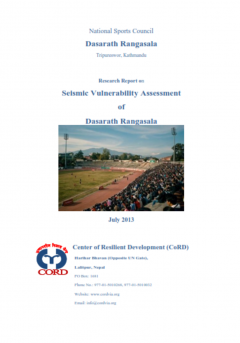Nepal is among the most disaster prone countries in the world. The country is ranked 11th in earthquake vulnerability, and Kathmandu is said to be exposed to the greatest earthquake risk among 21 megacities around the world. It had devastating earthquakes in 1934 and 1988.The earthquake of 1934 measuring 8.4 on the Richter scale is estimated to have killed over 16,000 people in Nepal and India. It caused extensive damage in Nepal: Over 8,500 lives were lost; over 80,000 houses were completely damaged, and over 126,000 houses were severely damaged, majority of them were of Kathmandu valley. The more recent earthquake of magnitude 6.6 in Udayapur district in 1988 killed 721 people and destroyed 64,476 houses.
Dasarath Stadium, a multi-purpose stadium is located in Tripureswor, Kathmandu, Nepal. It is the biggest stadium in Nepal. The stadium has a capacity to hold 25000 spectators including 5000 fixed seats in the main stand in the west side of the stadium. Built in 1961 AD, most of the national and international sport events and cultural and entertainment programs are held in this stadium.
Being located in Kathmandu, one of the highly seismic prone cities among 27 megacities of the world makes the stadium very susceptible to earthquakes. Furthermore, the structures of stadium is built more than 5 decades ago, which is the normal life of any concrete structures. As Kathmandu is potential to earthquake, stadium may put the people lives at risk. So it is high time to assess the seismic vulnerability of the facilities to ensure the smooth functioning of one of the iconic landmark of Nepal for national and international events.
Hence, the existing infrastructure should be subjected to vulnerability assessment tools in order to identify their strength, resilience and their vulnerability when subjected to a major earthquake.
